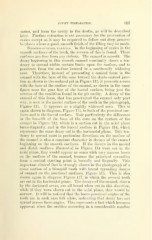Page 251 - My FlipBook
P. 251
CAVITY PREPAEATION. 107
caries, and form the cavity in the dentin, as will be described
later. Further extension is not necessary for the prevention of
caries except as it may be required to follow out deep grooves
to places where a good, smooth finish of the filling may be made.
Smooth-surface cavities. In the beginning of caries in the
smooth surfaces of the teeth, the reverse of this is found. These
surfaces are free from any defects. The enamel is smooth. The
decay beginning in this smooth enamel constantly shows a ten-
dency to spread within certain limits upon the surface, and to
penetrate from the surface inward in a continually widening
area. Therefore, instead of presenting a conical form in the
enamel with the base of the cone toward the dento-enamel junc-
tion as shown in the occlusal pit in Figure 112, it presents a cone
with the base at the surface of the enamel, as shown in the same
figure near the gum line of the buccal surface, being just the
reverse of the condition found in the pit cavity. A decay of the
enamel of this form, that has penetrated the enamel only part
way, is seen in the mesial surface of the tooth in the photograph,
Figure 111. It appears as a slightly whitened area. This is
again shown in diagram. Figure 114, in both of the proximal sur-
faces and in the buccal surface. Note particularly the difference
in the breadth of the base of the cone on the surface of the
enamel in Figure 112, which is a section cut in the axial plane
bucco-lingnially, and in the buccal surface in Figure 114, which
represents the same decay cut in the horizontal plane. This ten-
dency to spread most in particular directions on the surface of
the enamel is also a constant character in decays of the enamel
beginning on the smooth surfaces. If the decays in the mesial
and distal surfaces illustrated in Figure 114 were cut in the
axial plane, they would appear as cones with very narrow bases
on the surface of the enamel, because the principal spreading
from a central starting point is buccally and lingually. This
important clinical fact is strongly shown in the photograph of a
cross section of a bicuspid tooth with broad spreading decays
of enamel on the proximal surfaces. Figure 115. This is also
shown again in diagram Figure 117, in which the several teeth
are cut in the horizontal plane. The decays of the enamel, shown
by the darkened areas, are all broad when cut in this direction,
while if they were shown cut in the axial plane, they would be
narrow. It will be noticed that the bucco-proximal angles of the
teeth are in each case left white, indicating that decay has not
spread across these angles. This represents a fact which becomes
apparent when the cavities occurring in a considerable number


